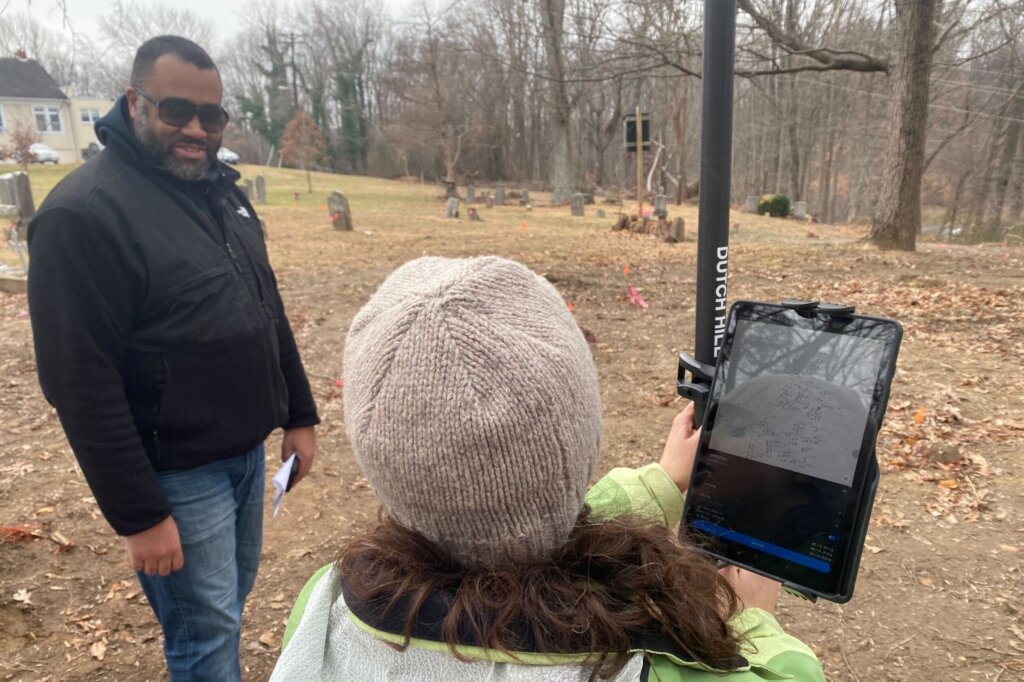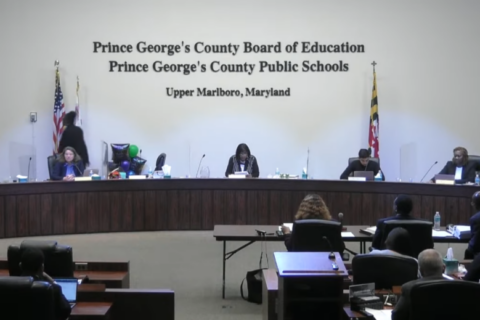For decades, the historic roots of Sacred Heart Catholic Church in Bowie, Maryland, have been a source of pride among parishioners.
What’s less talked about is the church’s connection to slavery. The Jesuits who started the church also ran a tobacco plantation, and enslaved Black people were relied on to operate it. Much of that land was sold off, and by the 1960s, new neighborhoods were being built where tobacco leaves once grew.
In fact, Sacred Heart itself, built in 1969, is now owned by the Archdiocese of Washington and not the Jesuits, though the Jesuits still own a few acres of nearby land on what was once known as the White Marsh. Efforts to sell that remaining land to developers a few years ago triggered discussion about unmarked graves that a few longtime parishioners knew about, but rarely talked about
This weekend, not only will they be talked about, but a massive effort will commence to properly recognize those who were laid to rest and intentionally forgotten about.
Behind the chapel and adjacent to a well-kept cemetery, a grass field is dotted with little flags. Many of them are next to stones. Inside the wood line there are more flags, and buried underneath decades of leaves, sticks and vines, it’s believed there are lots more stones.
Each flag and each stone is where someone was buried — in some cases, centuries ago.
“We knew there were burials in the woods,” said Rev. Michael Russo, a priest at Sacred Heart. “What we found were hundreds more burials than we thought would be there. Then they kept going in multiple different directions, and we decided we have to keep looking.”
Earlier in the week, the church confirmed about 140 to 150 unmarked grave sites on the property. By the end of the week, it was closer to 180.
On Monday, volunteers from the church and Catholic University will go into the woods with rakes and other pieces of landscaping equipment and begin clearing out the leaves and brush that have otherwise been ignored for decades. That work is expected to reveal even more grave sites.
“We’re looking at several hundred more burials, probably,” said Russo.
Most won’t be marked by anything more than a rock.
“We believe those to either be of African Americans or the enslaved,” said Russo. “They’re very easy to miss when covered with 100 years’ worth of leaves, dirt and grime. They weren’t noticed until landscapers started removing those leaves and debris. Then they started hitting these stones and realizing they were tombstones.”
In some cases, though few, there were graves marked by legitimate, proper tombstones, which included names and birth dates going back as far as the early 1800s. The church has reliable records dating back to the 1850s. However, the property goes back to the early 1700s.
The discovery — though acknowledgment is probably a better word — dredged up “mixed emotions.”
That’s how 42-year-old Kevin Porter of Kensington put it. Porter can trace direct descendants on the White Marsh plantation back to around 1810, maybe a few years before, but said he has ancestors who were there from the very beginning.
“In 1722, a planter-merchant named James Carroll, of the prominent Carroll family of Maryland, was granted this land by Lord Baltimore, the Calvert family, and he immediately began transitioning his enslaved family here,” said Porter.
“My ancestors, the Queen family, Mary Queen, was stationed here too. She was an immigrant (who) came over as an indentured servant and then was illegally enslaved by Carroll and the Jesuits. It was three generations later that they sued the Jesuits for their freedom.”

Even after it was granted, Porter said they remained on the land and helped keep the plantation going. It’s a similar story for Stephen Queen, who is Porter’s great-grandfather five times over. Born in 1810, but maybe as far back as 1807, it’s unclear if Queen was born a free man or not.
“From the records, he lived here all of his life,” said Porter. “He raised his family here. Attended chapel here. All of his children and grandchildren were baptized here at this chapel.”
But exactly where his permanent resting place sits is among the many mysteries buried on that hillside.
“This is a very important site for my family and America,” Porter said.
The chapel that sits at the top of a hill overlooking Maryland Route 450 dates back to the 1700s, and was where John Carroll, one of the founders of Georgetown University, was elected as America’s first Catholic bishop.
That chapel is where Catholicism in America got its formal start.
Porter said he’s aware of around 20 ancestors confirmed to have been buried at Sacred Heart. But he believes the actual number is much higher.
He’s hoping at least some of those grave sites can be identified, since some rocks are marked with names or initials. But most are unmarked.
“Known only to God,” is how Russo put it.
Dr. Laura Masur, archaeologist and assistant professor of anthropology at Catholic University, is leading the cleanup and documentation of this forgotten cemetery.
“When I heard about it, I said ‘oh, we need to do this right,’ because I had a feeling there would be a lot of interest just because of the scale of the cemetery,” she said.
Masur expects the mapping out of the cemetery, which includes land on a hillside that’s started to slowly collapse, will take much of 2023.
“A significant number are believed to be the remains of enslaved Blacks who worked the plantation that existed there,” said Russo. “We’re not sure how many yet. Part of clearing the underbrush and identifying stones will help us understand how many burials are here.”
“It’s amazing what goes through your head when you think about it,” admitted Porter.
Russo, who has been serving at Sacred Heart for only about a year-and-a-half, shared that sentiment.
“We need to know who’s here so we can pray for them, and we can be giving their burials the proper dignity and respect they’re owed,” said Russo. “Especially for the slaves. We need to honor them and acknowledge that they’re here and give them the respect and dignity they probably did not get in their lifetime.”
Masur has been talking with Porter and others whose ancestors are likely buried there about how to memorialize the land that’s been otherwise neglected for several lifetimes over.
There’s been talk of a memorial of some kind, whether it be a garden or marker that honors not only those buried there but also slaves who worked on the plantation and sold as part of the massive slave trade that helped keep Georgetown University afloat in 1828.
Some of the 272 slaves came from the White Marsh Plantation in Bowie, and that’s where their descendants now live. But other people whose ancestors worked this land are still living in the area.
Because everyone is so spread out, they get together once a month and speak about the project over Zoom.
“One of the things that really came out of that discussion was a desire to have family stories told,” said Masur. “It’s trying to bring out those stories. We’re never going to be able to identify specific individuals in every grave. But what we can do is to identify that they’re somewhere, and tell their stories.”
In an email sent to parishioners at Sacred Heart, Russo and Rev. Ronald Potts called this “an important act of justice and an essential corporal work of mercy” to undertake.
“What’s been going on in my head is, how do we treat them with dignity, how do we give them the honor they’re due and care for them in the future,” said Russo.
“First, we believe very firmly we have to locate as many as we possibly can. Once we know the size and scope of this, we can discern a path forward to marking the unmarked burials and determining the best way to honor all of these people here.”
But identifying as many graves as possible is just the first phase of work that will be happening. The same ground radar used to detect the burials on the north side of the property between the chapel and Route 450 didn’t detect any graves on the south side of the hill, where a ball field, grotto and outdoor altar now exist.
But the remnants of buildings were discovered. At this point, it’s not clear if those were buildings where the enslaved lived, or if they were structures related to farming and tobacco production. Eventually, Masur hopes to dig at the site and find out.
“There’s a lot of interest from a couple different communities about learning more about the property,” she said. “There’s been absolutely no archaeology there, which in some ways is daunting because there’s a lot of work to do. But in some ways, it’s really exciting, because you get to start out fresh.”
“I think this work needs to be done,” said Porter. “I’m excited that we’re able to now discover where the people that lived and worked and died here are actually buried and we can properly honor their legacy.”








